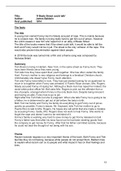BACTERIOLOGIE
DEEL A – ALGEMENE BACTERIOLOGIE
1. INTRODUCTIE
1.1 EVOLUTIE
Microbiële fossielen
o 1ste leven op aarde 3,5 tot 4 miljard jaren geleden:
(Fossiele) stromatolieten: afzettingsgesteenten met fossiele
filamenteuze micro-organismen, o.m. cyanobacteriën
(blauwalgen)
Waarneming van filamenteuze micro-organismen (1950)
(Fossiele) microbiële “matten”
Voornamelijk gevormd in intergetijden gebieden
Kerogen: organisch materiaal in oude gesteenten
> biologische activiteit
⇒ O2-productie door sommige bacteriën maakte ander leven mogelijk
, 1.2 HISTORISCH OVERZICHT
Voor 1650:
o Theorie van spontane generatie: ontstaan van levende organismen uit
niet-leven materiaal
o G. Fracastaro (ca. 1478-1553): zag als 1ste relatie tussen ziekte en
spreiding door direct contact, aanraking van kleding, lucht…
→ overdraagzaamheid van ziekte
Vanaf 17de eeuw:
o Ontwikkeling van microscoop (30x)
o Introductie van term ‘cel’ als entiteit in weefsel (Robert Hooke: 1635-
1703)
Van 1650-1850:
o Antoni van Leeuwenhoek (1632-1723)
Ontwikkelde lichtmicroscoop met hoge resolutie (270-480x)
Beschreef als 1ste bacteriën (1683): ‘animalcules’ – kleine
levende wezens
o Carolus Linnaeus (1707-1778)
Grondlegger huidige taxonomie:
‘Systema Naturae’ (1735)
→ basis zoölogische nomenclatuur
‘Species Plantarum’ (1753)
→ basis botanische nomenclatuur
Binaire nomenclatuur: genus- en speciesnaam
1ste classificatie bacteriën, vnl. gebaseerd op vorm (later andere
classificaties)
1850-1950:
o Louis Pasteur en medewerkers (1822-1895)
Weerlegde idee van ‘spontane generatie’: ‘kiemen’ aan basis
van bedorven voedsel, niet vice versa!
Ontwikkelde ‘ziektekiemtheorie’
Leverde bewijs van aanwezigheid van kiemen in lucht
Pasteurisatie: vernietiging van kiemen door verhitting
,o Robert Koch en medewerkers (1843-1910)
Bevestigde ziektekiemtheorie
Eerste aangetoond voor antrax (miltvuur), nadien voor
verschillende ziekten
Kochs postulaten: 4 voorwaarden om aan te tonen dat bepaalde
kiem ziekte veroorzaakt
, o Martinus Beijerinck (1851-1931)
Isolatie micro-organismen uit omgeving
Ontdekte verschillende groepen bacteriën:
Lichtgevende bacteriën
Sulfaat- en nitraatreducerende bacteriën
Methanogene micro-organismen
Grondlegger ecologische bacteriologie
o Sergei Winogradsky (1856-1953)
Beschreef als 1ste autotrofe, chlorofylvrije bacteriën (CO2 als
koolstofbron, H2S als energiebron)
Nitrificerende en N-fixerende anaerobe bacteriën
Grondlegger ecologische bacteriologie
Vanaf 1950: modern tijdperk
o Intrede biochemie
Onderzoek metabole processen: gelijkaardig in verschillende
organismen (Albert Jan Kluyver)
Algemene formules voor ademhaling, fotosynthese
Bacteriën: modelsysteem voor studie metabolisme
o Intrede moleculaire biologie
1953: ontdekking DNA-structuur (Watson & Crick)
Jaren ’60: ontdekking m/tRNA, regulatie proteïnesynthese,
kraken genetische code
Jaren ’70: intrede recombinant DNA-technologie
1995: 1ste genoomsequentie (> bacterie Haemophilus influenzae)
21ste eeuw: intrede van -omics (genomics, proteomics…)
1.3 DOMEINEN V/H LEVEN
Fylogenetische stamboom
o O.b.v. geconserveerde ribosomale RNA-sequenties: indeling levende
organismen in 3 domeinen
Bacteria:
Mitochondriën en chloroplast zijn van bacteriële oorsprong
en horen daarom bij de bacteriën
Archaea: leven vnl. in extreme omstandigheden
Hoge temperaturen
Hoge zoutconcentraties
…
Eukarya (eukaryoten)
Protisten (algen,
protozoa…)
Fungi (gisten,
schimmels,
zwammen)
Planten
Dieren
DEEL A – ALGEMENE BACTERIOLOGIE
1. INTRODUCTIE
1.1 EVOLUTIE
Microbiële fossielen
o 1ste leven op aarde 3,5 tot 4 miljard jaren geleden:
(Fossiele) stromatolieten: afzettingsgesteenten met fossiele
filamenteuze micro-organismen, o.m. cyanobacteriën
(blauwalgen)
Waarneming van filamenteuze micro-organismen (1950)
(Fossiele) microbiële “matten”
Voornamelijk gevormd in intergetijden gebieden
Kerogen: organisch materiaal in oude gesteenten
> biologische activiteit
⇒ O2-productie door sommige bacteriën maakte ander leven mogelijk
, 1.2 HISTORISCH OVERZICHT
Voor 1650:
o Theorie van spontane generatie: ontstaan van levende organismen uit
niet-leven materiaal
o G. Fracastaro (ca. 1478-1553): zag als 1ste relatie tussen ziekte en
spreiding door direct contact, aanraking van kleding, lucht…
→ overdraagzaamheid van ziekte
Vanaf 17de eeuw:
o Ontwikkeling van microscoop (30x)
o Introductie van term ‘cel’ als entiteit in weefsel (Robert Hooke: 1635-
1703)
Van 1650-1850:
o Antoni van Leeuwenhoek (1632-1723)
Ontwikkelde lichtmicroscoop met hoge resolutie (270-480x)
Beschreef als 1ste bacteriën (1683): ‘animalcules’ – kleine
levende wezens
o Carolus Linnaeus (1707-1778)
Grondlegger huidige taxonomie:
‘Systema Naturae’ (1735)
→ basis zoölogische nomenclatuur
‘Species Plantarum’ (1753)
→ basis botanische nomenclatuur
Binaire nomenclatuur: genus- en speciesnaam
1ste classificatie bacteriën, vnl. gebaseerd op vorm (later andere
classificaties)
1850-1950:
o Louis Pasteur en medewerkers (1822-1895)
Weerlegde idee van ‘spontane generatie’: ‘kiemen’ aan basis
van bedorven voedsel, niet vice versa!
Ontwikkelde ‘ziektekiemtheorie’
Leverde bewijs van aanwezigheid van kiemen in lucht
Pasteurisatie: vernietiging van kiemen door verhitting
,o Robert Koch en medewerkers (1843-1910)
Bevestigde ziektekiemtheorie
Eerste aangetoond voor antrax (miltvuur), nadien voor
verschillende ziekten
Kochs postulaten: 4 voorwaarden om aan te tonen dat bepaalde
kiem ziekte veroorzaakt
, o Martinus Beijerinck (1851-1931)
Isolatie micro-organismen uit omgeving
Ontdekte verschillende groepen bacteriën:
Lichtgevende bacteriën
Sulfaat- en nitraatreducerende bacteriën
Methanogene micro-organismen
Grondlegger ecologische bacteriologie
o Sergei Winogradsky (1856-1953)
Beschreef als 1ste autotrofe, chlorofylvrije bacteriën (CO2 als
koolstofbron, H2S als energiebron)
Nitrificerende en N-fixerende anaerobe bacteriën
Grondlegger ecologische bacteriologie
Vanaf 1950: modern tijdperk
o Intrede biochemie
Onderzoek metabole processen: gelijkaardig in verschillende
organismen (Albert Jan Kluyver)
Algemene formules voor ademhaling, fotosynthese
Bacteriën: modelsysteem voor studie metabolisme
o Intrede moleculaire biologie
1953: ontdekking DNA-structuur (Watson & Crick)
Jaren ’60: ontdekking m/tRNA, regulatie proteïnesynthese,
kraken genetische code
Jaren ’70: intrede recombinant DNA-technologie
1995: 1ste genoomsequentie (> bacterie Haemophilus influenzae)
21ste eeuw: intrede van -omics (genomics, proteomics…)
1.3 DOMEINEN V/H LEVEN
Fylogenetische stamboom
o O.b.v. geconserveerde ribosomale RNA-sequenties: indeling levende
organismen in 3 domeinen
Bacteria:
Mitochondriën en chloroplast zijn van bacteriële oorsprong
en horen daarom bij de bacteriën
Archaea: leven vnl. in extreme omstandigheden
Hoge temperaturen
Hoge zoutconcentraties
…
Eukarya (eukaryoten)
Protisten (algen,
protozoa…)
Fungi (gisten,
schimmels,
zwammen)
Planten
Dieren











